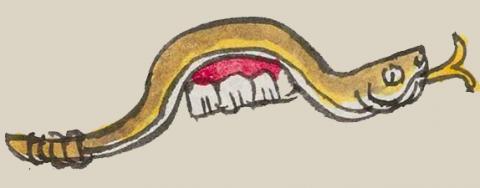Coatitlan (Mdz17v)
This compound glyph for the place name Coatitlan features two elements, a full-length snake {coatl) in profile, facing to the right, and a set of two front teeth {tlantli), which provides the phonetic value for the locative suffix -tlan. The snake or serpent is a two-tone golden brown, with a white belly, and a rattler for a tail. Its bifurcated tongue is yellow.
Stephanie Wood
Note how the teeth are four, which is more than is often the case, but they fill the curve in the body of the snake, which might be an example of artistic license. A similar case is the compound glyph for Chontal Coatlan (below, right). Many snakes have a red tongue; it is not clear why this one is yellow or if it has an iconographic significance. The rattler can also be a different color from the body, but here is it not. Finally, the white stomach is sometimes segmented, but not here.
Stephanie Wood
coatitlan.puo
Coatitlan, pueblo
Stephanie Wood
c. 1541, or by 1553 at the latest
Stephanie Wood
snakes, serpents, culebras, serpientes, cohuatl, nombres de lugares, crótalos

coa(tl), snake or serpent, https://nahuatl.wired-humanities.org/content/coatl
tlan(tli), tooth/teeth, https://nahuatl.wired-humanities.org/content/tlantli
-tlan (locative suffix), by, near, among, https://nahuatl.wired-humanities.org/content/tlan
"Among the Snakes" (Karttunen she does not offer an alternative reading to the Berdan and Anawalt reading) [Frances Karttunen, unpublished manuscript, used here with her permission.]
"Among the Snakes" (Berdan and Anawalt, 1992, vol. 1, p. 179)
Codex Mendoza, folio 17 verso, https://digital.bodleian.ox.ac.uk/objects/2fea788e-2aa2-4f08-b6d9-648c00..., image 45 of 188.
The Bodleian Libraries, University of Oxford, hold the original manuscript, the MS. Arch. Selden. A. 1. This image is published here under the UK Creative Commons, “Attribution-NonCommercial-ShareAlike 3.0 License” (CC-BY-NC-SA 3.0).

